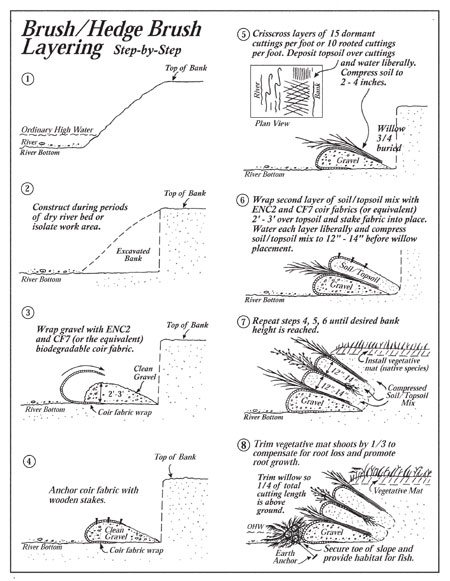Streambank Revegetation and Protection: A Guide for Alaska
Revegetation Techniques: Hedge-Brush Layering
Brush layering is a revegetation technique, which combines layers of dormant or rooted cuttings (see Dormant Cuttings under Plant Care and Preparation section) with soil to revegetate and stabilize both streambanks and slopes. A larger variety of plant species may be utilized with a hedge brush layer (dormant cuttings and rooted plants) than with a simple brush layer (dormant cuttings). Rooted plants of species that do not root readily, such as alder, Scouler and Bebb Willow, can be included in the plant layer. A mixture of species may allow the revegetation project to blend with existing vegetation. Branches are placed on an angled bench that follows the contour of the slope and provides reinforcement to the soil. Steep slopes and streambanks are better stabilized when a biodegradable revegetation fabric is used to hold the reinforced soil lifts in place between the plant layers. Plant material placed using brush layering provides fish habitat and nutrients to the adjacent water body.
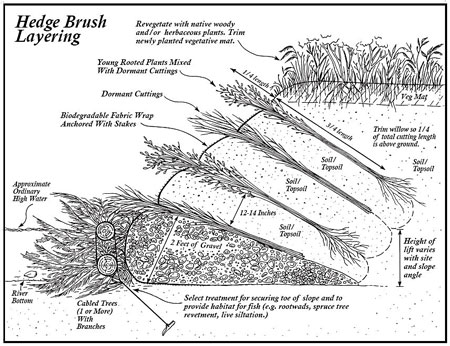
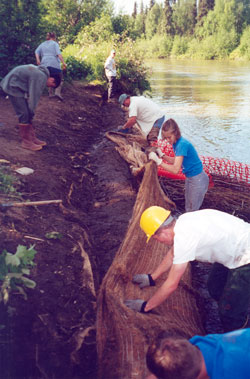
Collection, storage and planting information are described under Dormant Cuttings in the Plant Care and Preparation section. Different species of woody cuttings that root easily (see Plant Species Selection List, Shrubs and Trees) can be mixed in the layers; rooted plants can also be added to create a hedge-brush layer (see Root Pruning under the Plant Care and Preparation section). Rooted plants may be planted throughout the growing season from spring through early fall. Dormant plants, if collected in the spring, should be planted before July 1 of that year.
Choose a technique such as root wads, live siltation, coir logs, or cabled spruce tree revetments to secure the toe of the slope. Consult streambank revegetation professionals and evaluate site conditions to determine the treatment of the toe-of-slope. Perform all construction activities during periods of dry riverbed; dewater area, or isolate the work area (see Erosion Control section). Along a water body, the first brush layer typically occurs at the OHW (ordinary high water) level, often identified by the line of growing vegetation (plus other factors).
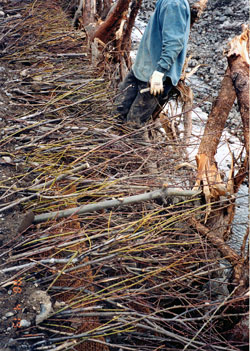
Prepare a bench, which corresponds to the bank depth necessary to stabilize the slope, either through excavation or building up the slope, so that it angles slightly down and into the bank. It is important to note the upstream and downstream riparian species and slope height and angle when designing a brush layer project. Specifications should represent the local native environment as much as possible. If the surrounding area has been greatly impacted, observation further upstream and downstream may be necessary. Place fifteen dormant branches on the bench per foot or ten rooted cuttings per foot, slightly crisscrossed (see Hedge Brush Layering/Brush Layering). A mixture of dormant cuttings and rooted plants may be used. The cut or rooted ends are placed into the slope with the tips extending beyond the edge of the bench no more than 1/4 of the total branch length. Place 2 to 4 inches of soil on top of the branches, water and tamp into place.
The reinforced soil lift is placed directly on top of the brush layer, pulling the next step back according to the designed bank angle. Two revegetation fabrics are used in reinforced soil lifts to keep soil in place when a brush layer is installed on steep slopes and streambanks. The first fabric layer, a fine mesh fabric (example: Bon Terra's® ENC2, North American Green's C125 BN, or equivalent) is placed inside the larger mesh fabric (example: Bon Terra's® CF7, North American Green's CCM-700, or equivalent). Next, 12-14 inches of soil-topsoil mix is placed on top of the fabric, watered, compressed and 2-3 feet of fabric is rolled over the top and secured in place with wooden stakes. Follow this step by another layer of dormant cuttings/rooted plants.
Repeat the branch, topsoil, wrapped soil/topsoil mix layering sequence until the desired bank height is achieved (see Hedge Brush Layering/Brush Layering). Trim plants back to 1/4 of the planting above ground, 3/4 of the planting below ground. A vegetation mat may be placed on the top layer of the bank after the last brush layer is installed and overtopped with soil. The vegetative mat should be harvested and installed according to the Transplanting section and the shoots should be cut back by 1/3 to compensate for root loss and to encourage new root growth.
Higher density plantings are needed for more erosive sites and if the diameter of the plant material is small. Sites with a shallow slope and low erosion potential can have wider vegetation spacing than sites with a steep slope and higher erosion potential. This technique can be easily mechanized, layer-by-layer, if it is installed during construction of a fill slope. On cut slopes and existing banks each layer must be excavated.
Advantages:
- Prevents soil erosion and stabilizes bank
- Provides fish habitat and native vegetation
- Reestablishes healthy riparian zone functions
- May be used in higher velocity systems, dependant on toe-of-slope protection
- High success rate
- No permanent geotextile fabrics or metal left in bank
Disadvantages:
- Relatively expensive
- More technologically challenging, requires expertise
- May require heavy machinery
- Requires isolated work area to prevent water body siltation
- Very stable, dependent on toe-of-slope stabilization
- May require significant training
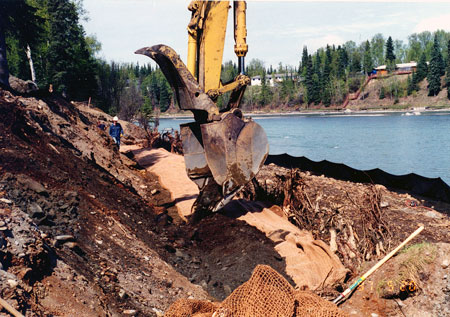
For PDF version (PDF 918 kB)
